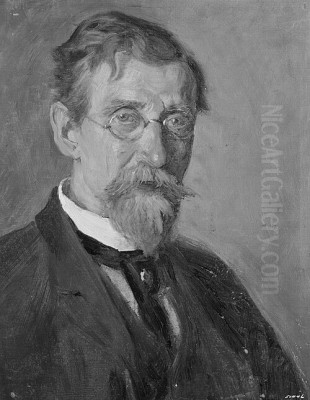
Theodore Clement Steele stands as a pivotal figure in the story of American Impressionism, particularly celebrated for his evocative landscape paintings that captured the unique beauty and changing light of his native Indiana. Born on September 11, 1847, and passing on July 24, 1926, Steele's life spanned a period of significant artistic transformation in the United States. He rose from humble beginnings to become the most renowned member of the "Hoosier Group," a collective of Indiana artists who brought a distinct Midwestern voice to the Impressionist movement that had originated in France. His dedication to depicting the familiar scenes of his home state established him not only as a regional master but also as an important contributor to the broader narrative of American art at the turn of the twentieth century.
Early Life and Artistic Awakening
Theodore Clement Steele's journey began in Owen County, Indiana, a rural setting that would later deeply inform his artistic vision. His childhood was marked by the early death of his father, Samuel Steele, which placed financial strain on the family. Young Theodore contributed by working on the farm, yet his artistic inclinations were evident from an early age. Crucially, his mother, Harriett Newell Evans Steele, recognized and nurtured his talents, ensuring he received education not only in standard subjects but also in art and music, despite their modest means. This maternal support proved foundational for his future path.
His formal artistic training commenced at the Waveland Collegiate Institute (often referred to as Waveland Academy) in nearby Montgomery County. Even in these early stages, his aptitude for drawing and painting was apparent. Seeking further development, he later pursued studies in Chicago, immersing himself in the burgeoning art scene of the city. These initial educational experiences laid the groundwork for a more ambitious step: traveling abroad to hone his craft in one of Europe's major art centers. The landscapes and experiences of his Indiana youth, however, remained ingrained, waiting to be revisited through the lens of mature artistic skill.
Formative Years Abroad: The Munich Experience
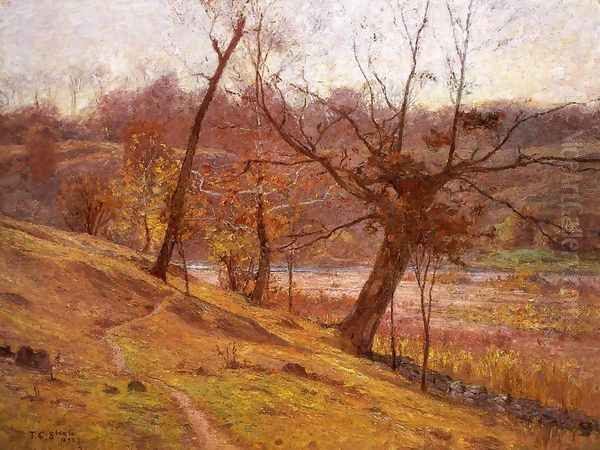
In 1880, seeking the rigorous training offered by European academies, Steele, along with his family, embarked for Germany. He enrolled in the prestigious Royal Academy of Fine Arts in Munich, a major center for artistic study that attracted aspiring painters from across Europe and America. Munich at this time was known for a style characterized by dark palettes, dramatic tonal contrasts, and bravura brushwork, often focused on portraiture and genre scenes. Steele studied under instructors like Ludwig von Löfftz and Gyula Benczúr, absorbing the technical proficiency emphasized by the Academy.
During his five years in Munich (1880-1885), Steele associated with other American artists who were also refining their skills abroad. Figures like J. Frank Currier and the influential Cincinnati-born painter Frank Duveneck were part of this milieu. The "Duveneck Boys," as some of his followers were known, embraced the dark, painterly realism popular in Munich. Steele's work from this period reflects this influence, often featuring rich, somber tones and a focus on capturing character and form through vigorous brushwork, distinct from the lighter palette he would later adopt. His exposure to the Old Masters in European museums, particularly the dramatic light and shadow of artists like Rembrandt and the painterly realism of Frans Hals, also profoundly shaped his understanding of technique and composition.
While in Munich, Steele gained valuable technical skills and a deeper understanding of European artistic traditions. He participated in exhibitions and began to build a reputation. However, the dark tonality prevalent in the Munich school would eventually give way to a different approach upon his return to the United States and his subsequent encounter with Impressionism. The Munich years were crucial, nonetheless, providing him with the academic foundation upon which he would build his unique artistic identity. His contemporary, William Merritt Chase, another highly influential American artist and teacher, also spent formative years studying in Munich slightly earlier, highlighting the city's importance for that generation of American painters.
Return to Indiana and Establishing a Career
Upon returning to Indianapolis in 1885, Steele faced the practical challenge of establishing himself as a professional artist. Initially, portraiture provided a necessary source of income. He became sought after for his ability to capture likenesses, and his commissions included prominent citizens and officials. Notably, he painted the official portraits of five Indiana governors, solidifying his reputation within the state. These portraits, while often adhering to the formal conventions required, still showcased the technical skill honed during his Munich years.
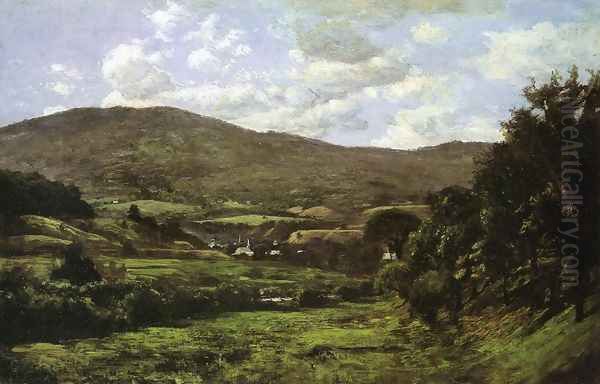
However, Steele's passion increasingly leaned towards landscape painting. The familiar Indiana scenery, which he had known since childhood, called to him. Alongside his portrait work, he began exploring the woods, fields, and waterways around Indianapolis, sketching and painting outdoors whenever possible. This period marked the beginning of his lifelong dedication to capturing the specific atmospheric conditions and subtle beauty of the Midwestern landscape.
Recognizing the need for formal art instruction in the city, Steele, together with fellow artist William Forsyth – another Indiana native who had also studied in Munich – co-founded the Indiana School of Art in Indianapolis in 1889. This venture aimed to provide local students with the kind of rigorous training they themselves had sought in Europe. Although the school faced financial difficulties and was relatively short-lived, it represented an important step in fostering a local art community and demonstrated Steele's commitment not only to his own art but also to art education in his home state.
The Embrace of Impressionism
A significant turning point in Steele's artistic development occurred following his exposure to French Impressionism. While direct influence during his European stay was limited (Impressionism was still gaining traction outside France), the 1893 World's Columbian Exposition in Chicago provided a major platform for international art, including works by French Impressionists like Claude Monet and Camille Pissarro. Seeing these works, characterized by their bright palettes, broken brushwork, and focus on capturing fleeting moments of light and atmosphere, profoundly impacted Steele and many other American artists.
Steele began to consciously move away from the darker, tonal style of his Munich training towards the lighter, more vibrant approach of Impressionism. He increasingly adopted the practice of plein air painting – working outdoors directly from nature – to better capture the immediate effects of sunlight and atmosphere. His palette brightened considerably, incorporating purer colors and exploring the optical effects of light on surfaces. His brushwork became looser and more visible, suggesting form and texture rather than meticulously rendering detail.
His 1893 painting, The Bloom of the Grape, exhibited shortly after the Columbian Exposition, clearly shows this stylistic shift. It features the dappled sunlight, vibrant greens, and atmospheric haze characteristic of his mature Impressionist style. While rooted in the American landscape tradition, Steele's interpretation of Impressionism focused on the specific qualities of the Indiana environment – the hazy light of summer, the rich colors of autumn, the stark beauty of winter snow. He wasn't merely imitating French techniques; he was adapting them to express his deep connection to his native region.
The Hoosier Group: A Regional Identity

Steele was not alone in his artistic endeavors in Indiana. He became the leading figure of what is known as the "Hoosier Group," a circle of five painters who dominated the Indiana art scene from the 1890s through the early twentieth century. Besides Steele, the core members were William Forsyth (his partner in the art school venture), Otto Stark, J. Ottis Adams, and Richard Gruelle. All except Gruelle had studied in Munich, sharing a common foundational experience, yet each developed a distinct artistic personality.
The Hoosier Group gained significant recognition following a joint exhibition in Chicago in 1894, titled "Five Hoosier Painters." This exhibition helped establish their collective identity and brought critical attention to the burgeoning art movement in Indiana. They were united by their commitment to depicting local scenery and their adaptation of Impressionist techniques to the Midwestern landscape. Their work celebrated the beauty of the ordinary – creek beds, rolling hills, farm fields, and woodlands – finding artistic inspiration in subjects previously overlooked by the mainstream art world focused on grander, more exotic locales.
Steele, often considered the "dean" of the group due to his established reputation and artistic maturity, played a central role. His work exemplified the group's aims: a truthful yet poetic rendering of the Indiana landscape, infused with light and atmosphere. The Hoosier Group collectively helped to cultivate regional pride and demonstrated that significant art could arise from the American heartland, contributing to a broader movement towards American artistic independence from European dominance. Their success paved the way for future generations of Indiana artists.
Masterworks and Signature Themes
Theodore Clement Steele's most celebrated works are undoubtedly his landscapes of Indiana. He possessed an uncanny ability to capture the specific quality of light and atmosphere in the region throughout the changing seasons. His paintings often depict the gentle, rolling hills, meandering creeks, and dense woodlands characteristic of central and southern Indiana, particularly areas like the Whitewater Valley near Brookville and, later, Brown County.
The Bloom of the Grape (1893) remains one of his iconic early Impressionist works, showcasing his newfound mastery of light and color in depicting a sun-dappled vineyard. Okemo Mountain (1887), painted earlier, reflects a transitional phase, still showing some Munich influence but moving towards a greater emphasis on atmospheric effects. Tennessee Mountains (1899) demonstrates his skill in capturing broader vistas, likely painted during travels outside Indiana.
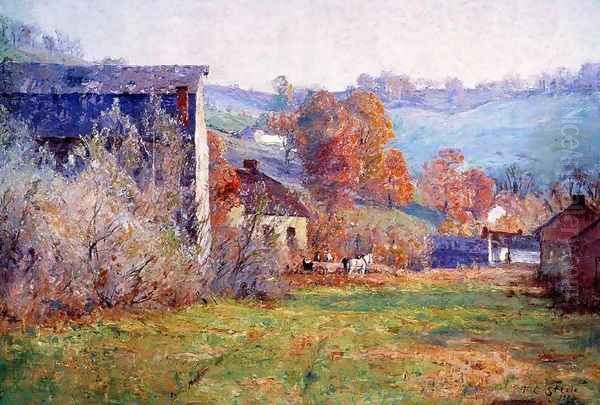
Works like Sugar Creek (1888) and numerous paintings simply titled Whitewater Valley or depicting specific locations like the Old Mills reveal his fascination with water, reflections, and the interplay of light on foliage. He was particularly adept at painting the hazy, humid light of Indiana summers (A Summer Day) and the brilliant, crisp light of autumn, rendering the fall foliage with a rich, jewel-like palette. Winter scenes, often featuring snow-covered landscapes under subtle grey skies or bright sunlight, also form an important part of his oeuvre, showcasing his ability to find beauty in the starkness of the season. His dedication to painting the same locations repeatedly under different conditions aligns him with Impressionist masters like Monet, who famously studied haystacks and Rouen Cathedral in varying light.
Brown County and the House of the Singing Winds
A significant chapter in Steele's later life and career began after the tragic death of his first wife, Mary Elizabeth "Libbie" Lakin Steele, from tuberculosis in 1899. Seeking solace and new inspiration, Steele was increasingly drawn to the rugged, picturesque beauty of Brown County in southern Indiana. Its rolling hills, deep ravines, and largely undeveloped landscape offered a wealth of subject matter. In 1907, after marrying his second wife, Selma Neubacher Steele, he purchased land near Belmont and built a hilltop home and studio he named "The House of the Singing Winds."
This move solidified Brown County's destiny as a major art colony. Steele's presence acted as a magnet, attracting other artists to the area. The House of the Singing Winds, with its expansive studios and beautiful gardens meticulously designed and tended by Selma, became a central gathering place for artists and visitors. Steele spent the rest of his life there, dedicating himself almost exclusively to painting the surrounding landscape. His Brown County paintings are perhaps his most iconic, capturing the unique atmospheric haze and vibrant seasonal colors of the region.
The Brown County Art Colony flourished, becoming one of the most significant regional art centers in the Midwest. Artists who worked there alongside or were influenced by Steele included Adolph Shulz and his wife Ada Walter Shulz, the printmaker Gustave Baumann, landscape painter Will Vawter, and Glen Cooper Henshaw, among many others. Steele served as a mentor and inspiration to many in the colony, fostering a collaborative yet individualistic spirit. His home and studio became a testament to his deep integration with the landscape he so loved to paint.
National Recognition and Exhibitions
While deeply rooted in Indiana, T.C. Steele achieved recognition on a national and even international scale. His participation in major exhibitions was crucial in building his reputation beyond the Midwest. Following his notable presence at the 1893 World's Columbian Exposition, he continued to submit works to important juried shows. His paintings were included in the Louisiana Purchase Exposition held in St. Louis in 1904, where he received an honorable mention, further validating his standing among American artists.
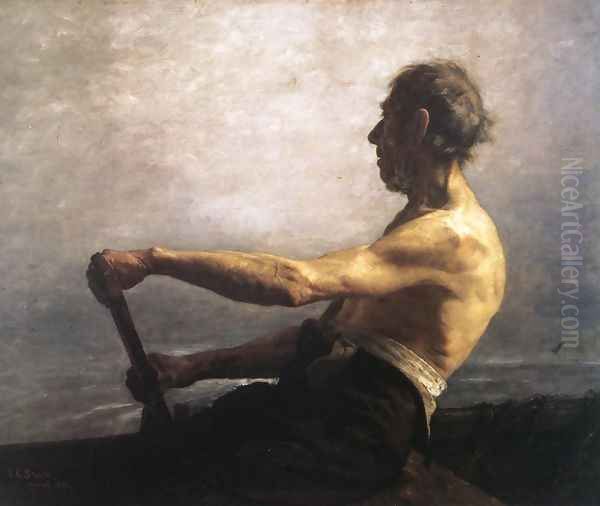
Steele's reach extended internationally when his work was selected for the International Fine Arts Exhibitions held in Buenos Aires, Argentina, and Santiago, Chile, in 1910. This exposure introduced his distinctly American landscapes to audiences abroad. He also exhibited at the prestigious Panama-Pacific International Exposition in San Francisco in 1915, another major event showcasing American art and industry. These exhibitions placed his work alongside that of the leading artists of his day, confirming his place within the national art scene.
Beyond exhibiting, Steele was active in arts organizations. He was a key figure in the Society of Western Artists, serving as its president and helping to organize exhibitions that promoted the work of artists from the Midwest. His expertise was recognized through invitations to serve on art juries for various exhibitions, both regional and national. In 1913, he received a significant honor when he was elected an Associate Member of the National Academy of Design in New York, a mark of high esteem from the country's premier art institution. Wabash College (1900) and Indiana University (1916) further recognized his contributions by awarding him honorary degrees.
Later Life and Legacy
In his later years, Theodore Clement Steele continued to paint prolifically from his Brown County home, solidifying his status as the elder statesman of Indiana art. He served as Indiana University's first artist-in-residence from 1922 until his death, painting on campus in Bloomington during the winter months and returning to Brown County for the warmer seasons. His presence on campus helped to integrate fine arts into the university's academic life. His daughter from his first marriage, Margaret "Brandt" Steele, also became an accomplished artist, known particularly for her work in California, carrying on the family's artistic inclinations.
Steele passed away in Brown County in 1926. His wife, Selma, dedicated herself to preserving his legacy. She continued to maintain the House of the Singing Winds and its gardens, welcoming visitors and ensuring her husband's work remained accessible. In 1945, she generously donated the entire 211-acre property, including the house, studios, contents, and hundreds of Steele's paintings, to the state of Indiana. Today, the T.C. Steele State Historic Site stands as a living museum, offering visitors a unique glimpse into the artist's life, working environment, and the landscape that inspired him.

Theodore Clement Steele's legacy endures through his vast body of work, which continues to be celebrated for its beauty, sensitivity, and authentic portrayal of the American Midwest. His paintings are held in numerous museum collections, including the Indianapolis Museum of Art at Newfields, the Indiana State Museum, the Indiana University Art Museum, and the Los Angeles County Museum of Art. He remains a foundational figure in Indiana art history and a significant representative of American Impressionism, remembered for his dedication to capturing the light and spirit of his beloved home state. His influence extended to contemporaries like Chicago artists Charles Dahlgren and Lucie Hartrath, who also focused on Midwestern landscapes.
Conclusion
Theodore Clement Steele's life and art offer a compelling narrative of dedication, adaptation, and regional pride. From his early training in the academic traditions of Munich to his wholehearted embrace of Impressionism, he forged a style uniquely suited to capturing the landscapes of Indiana. As the leading figure of the Hoosier Group and a central force in the Brown County Art Colony, he not only created a significant body of work but also helped to foster a vibrant artistic community in the American Midwest. His paintings, celebrated for their luminous color, atmospheric depth, and intimate connection to place, continue to resonate with audiences, securing his position as a major figure in the history of American landscape painting and a beloved interpreter of the Indiana scene. His journey demonstrates the power of an artist deeply connected to their roots, translating the familiar into the universal language of art.